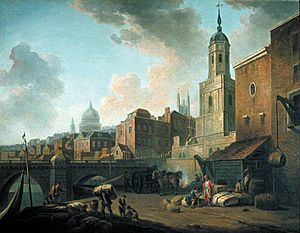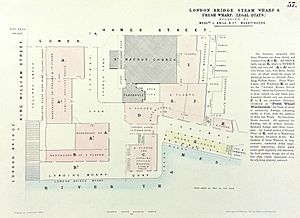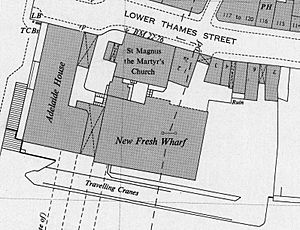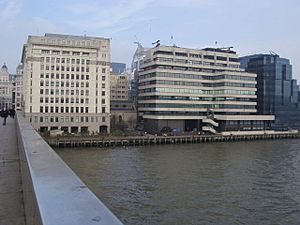Fresh Wharf facts for kids
Fresh Wharf was a busy dock, also called a wharf, located in the City of London right next to London Bridge. It sat on the north bank of the River Thames. This spot has a long history, being used as a landing place for boats since Roman times and later by Anglo-Saxon ships.
A proper wharf was built here sometime in the Middle Ages. It likely got its name because it was a popular spot for unloading fresh fish. In the 1500s, during the reign of Queen Elizabeth I of England, Fresh Wharf was made a "Legal Quay." This meant it was officially allowed to import certain goods. As London's river trade grew in the 1700s and 1800s, Fresh Wharf expanded, with large warehouses built nearby. In the 1900s, the owners bought the docks next to it, built a new ten-story warehouse, and renamed the whole area New Fresh Wharf.
However, by the late 1960s, London's traditional docks became less useful. This was because of containerization, a new way of shipping goods in large metal boxes that the old docks weren't designed for. New Fresh Wharf closed in 1970. Today, an office building stands where the warehouse once was, and the old dockside is now part of a public walking path along the Thames.
Contents
Fresh Wharf's Long History

A dock existed at this location as far back as the Roman period, but it seems it wasn't used after 260 AD. Its construction showed how climate change affected things even then. A period of colder temperatures meant more water was frozen in polar icecaps. This caused the sea level, and therefore the level of the Thames, to drop a lot over several centuries after Roman Londinium was founded.
In the second century AD, a river wall (called a revetment) was built at Fresh Wharf. But by the third century, the river level had dropped so much that the docks had to be built much further out into the river to keep the water deep enough for ships. At Fresh Wharf, a timber dock was built about 8.25 meters (27 feet) in front of the older river wall.
We don't know the exact date Fresh Wharf was first established. In the late Anglo-Saxon period (around the 900s and 1000s), the area seems to have been just a beach where ships would land to unload. A proper dock was built there sometime later in the Middle Ages. Its name was first written down as Fresshffysshewharfe in 1363. This name probably came from its common use as a place to unload fresh fish. On land, you could reach the wharf from Lower Thames Street, a short distance from the church of St Magnus-the-Martyr. Digs in 1974–75 found many interesting things about the medieval buildings there.
In 1559, Fresh Wharf became one of the twenty "Legal Quays" in the City of London. This meant it was officially approved by the state as a place for traders to load and unload goods. The wharf was specifically listed for "fyshe and eele shippers." During the Great Fire of London in September 1666, which began very close by in Pudding Lane, Fresh Wharf and all the other Legal Quays were destroyed. However, they were quickly rebuilt and were all back in business by the mid-1670s. Another fire on April 18, 1760, burned down the wharf and some of the surrounding area. The ownership of the wharf changed hands several times. One famous owner was the actor David Garrick, who invested in the wharf in 1776. Sadly, this investment didn't turn out well for him.
Fresh Wharf in the 1800s
In 1824, official records about the Port of London showed that Fresh Wharf had a river frontage of 137 feet (about 42 meters). This made it the second-largest of the Legal Quays. All the Legal Quays, including Fresh Wharf, were bought by the government in 1805. But in 1827, a dock manager named John Knill leased the wharf for a yearly rent of £1,555 after buying the land from the Crown.
By the 1840s, the wharf was busy with schooners, which are sailing ships, bringing fruit from places like the Canary Islands, Azores, and the Mediterranean Sea. Sometimes, as many as a dozen ships would unload at once, bringing six million oranges to London every year! The wharf mainly handled foreign goods, mostly fruit, but also silk and wines. It did not accept dangerous goods. Fresh Wharf worked together with London Bridge Wharf, which was used by smaller coastal ships and steamships.
Around this time, Fresh Wharf was described as "covering an immense space of ground." It had many tall warehouses that held goods worth over a million pounds sterling. Most of the warehouses were new and made of brick, except for an "very old" timber building called Crane House. On June 21, 1858, a fire badly damaged the wharf again, destroying about £100,000 worth of goods stored in the warehouses.
The Knill family continued to run Fresh Wharf for the rest of the 1800s. They became a very important family, even gaining a special title called a baronetcy. Sir John Stuart Knill, the second baronet, became the first Roman Catholic Lord Mayor of London in 1892.
The 1900s: New Fresh Wharf
At the start of the 1900s, Fresh Wharf was a very busy and successful business. It handled 300,000 tons of cargo and over a quarter of a million passengers each year. The Fresh Wharf Company grew even more in the 1930s. They leased the entire river frontage from London Bridge Wharf (in front of the 1925 Adelaide House) all the way to its neighbor, Cox and Hammond's Quay. Cox and Hammond's Quay had also been a Legal Quay since 1559.
The combined wharves were now called New Fresh Wharf and had two berths, which are places where ships can dock. The larger berth was 455 feet (about 139 meters) long and could hold ships weighing up to 7,000 tons. New Fresh Wharf was the closest steamship dock and warehouse area to the very center of the City of London. By 1937, New Fresh Wharf had 28 cranes and handled many different types of goods, including fresh fruit and canned foods. A new dock was built in front of the wharf in the 1930s, and the existing pier at London Bridge Wharf was made longer.
Besides handling goods, New Fresh Wharf was also used by passenger steamships. The Queen Line, part of the New Medway Steam Packet Company, ran daily services from here to towns like Southend-on-Sea, Herne Bay, Margate, and Ramsgate. Another route went to Southend, Clacton-on-Sea, Walton-on-the-Naze, and Felixstowe. However, the company moved its operations to Tower Pier around 1935. Passenger services also ran twice a week to Amsterdam with the Holland Steamship Company.
The wharf almost got destroyed during World War II when its neighbor to the south, Nicholson's Wharf, was flattened by a V-1 flying bomb. After the war, a regular passenger and cargo service between the wharf and the Canary Islands was kept going for several years by two large ships, the MV Monte Ulia and its sister ship MV Monte Urquiola. These were some of the biggest merchant ships ever to visit the Pool of London. In 1963, writer James Harold Bird noted how "during his lunch-hour the pale-faced London office worker can lean on the downstream parapet of London Bridge and watch Canary Island produce being unloaded to New Fresh Wharf below from vessels up to 500 feet long and delivered to a ten-storey warehouse." This large warehouse was built in 1953 and had four million cubic feet of storage space. By this time, the wharf had five moving cranes and two conveyors, which could carry loads up to five tons. Its river frontage was 585 feet (about 178 meters) long.
Closure and New Buildings
Just a few years after Fresh Wharf was described as so busy, the inner London docks became unused. This happened because trade moved to the new container port further down the river at Tilbury Docks. New Fresh Wharf closed for good in 1970. In 1973, the large warehouse was torn down.
Archaeological digs on the site between 1974 and 1978 uncovered the remains of the old Roman dock and river wall. The demolished warehouse was eventually replaced by St Magnus House, an office building designed by Richard Seifert, which was built in 1978.





